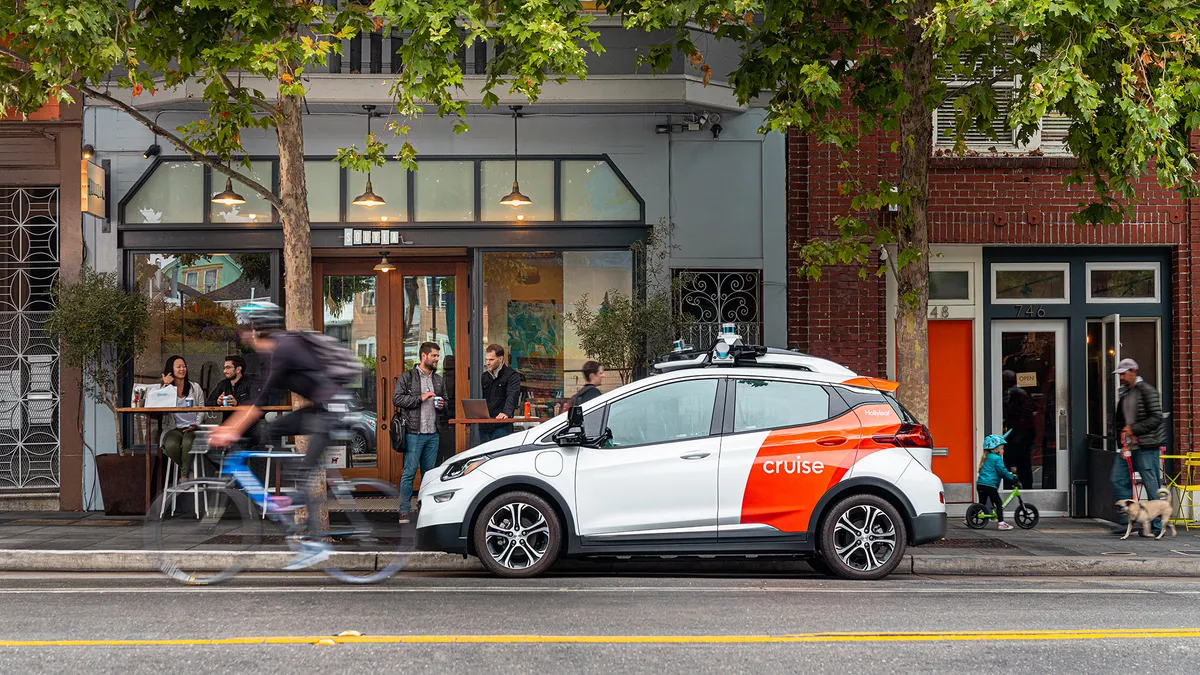Dive Brief:
- General Motors Co.’s autonomous driving unit Cruise has recalled all its Chevy Bolt ride-hailing vehicles running a version of its Automated Driving System software that was released prior to May 14, according to the National Highway Traffic Safety Administration.
- Cruise AVs equipped with the older software may unexpectedly brake if a cyclist or vehicle approaches from the rear, increasing the chance of a collision. The recalled software was installed in all of the 1,194 vehicles in Cruise’s U.S. fleet.
- The safety of the Cruise’s autonomous vehicles has been under extra scrutiny since last year after an incident where one of its vehicles struck and seriously injured a pedestrian in San Francisco that resulted in its fleet being grounded by regulators.
Dive Insight:
The NHTSA’s Office of Defects Investigation opened a preliminary evaluation of the unexpected braking events and immobilizations of Cruise vehicles on Dec. 12, 2022, after it received three reports of rear-end collisions with Cruise vehicles that initiated a hard-braking maneuver. In all three cases, the vehicle was being operated autonomously in “supervised mode” with a safety driver behind the wheel monitoring the vehicle’s behavior.
Cruise completed software updates throughout 2023, as well as during the pause of its operations from Oct. 26, 2023, through May 13, 2024. The updates included improvements to the vehicle’s perception, prediction and path planning capabilities to reduce the risk of unexpected braking, according to the NHTSA.
Cruise met with NHTSA officials on Feb. 29, and again on May 9, to follow up and demonstrate to the agency the effectiveness of its updated software. The NHTSA noted that Cruise complied with all of its information requests and provided various documents and videos for the agency to review.
After the ODI’s analysis, the NHTSA still requested on July 17 that Cruise file a safety recall, which the company did on Aug. 9. Following the recall, the ODI said it was closing its investigation of the sudden braking problem, but reserves the right to take additional action if any other incidents with the Cruise AVs are reported.
For the investigation, the ODI collected information from Cruise, as well as from five peer autonomous vehicle operators, according to the recall report. This included an analysis of data from 7,632 hard-braking events that were commanded by software in the Cruise vehicles.
The ODI concluded that the software problem contributed to 10 crashes, four of which involved a “vulnerable road user” and resulted in injury.
Based on its analysis, the braking problem was determined to be largely dependent on the vehicle’s location and “detectability of the vehicle due to hazard lights automatically engaging,” according to the NHTSA report.
In January, the Department of Justice and Securities and Exchange Commission opened investigations into the October 2023 incident in San Francisco where a Cruise robotaxi struck a woman and dragged her under the vehicle.
The January probe followed an initial investigation by the NHTSA and the California Public Utilities Commission, which resulted in the suspension of Cruise’s permits to operate its vehicles on public roads in the state.
Following the incident, Cruise also dismissed nine of its top executives and laid off 24% of its workforce in December 2023. This executive shakeup followed the resignation of Cruise co-founders, former CEO Kyle Vogt and Daniel Kan, in November of that year.
In April, Cruise began deploying mapping vehicles on public roads in Phoenix again for the first time since it was forced to pause operations last fall. The company will gradually expand its mapping operations as it reaches its predetermined safety benchmarks.
Cruise is now also testing its AVs in Dallas and Houston, GM CFO Paul Jacobson said during the Q2 automaker’s earnings call. However the vehicles will not be picking up paying passengers as the company continues to refine its autonomous driving system.
“I'm very confident as we now have vehicles operating and we're on the path very quickly to get to — back to driverless with much safer technology,” said GM CEO Mary Barra during the company’s earnings call.













